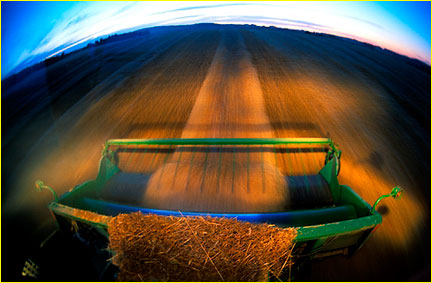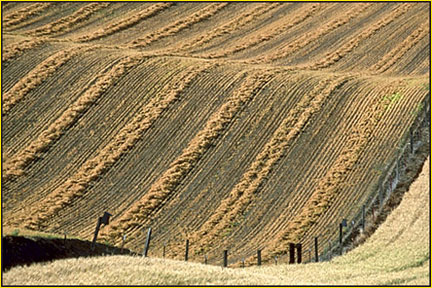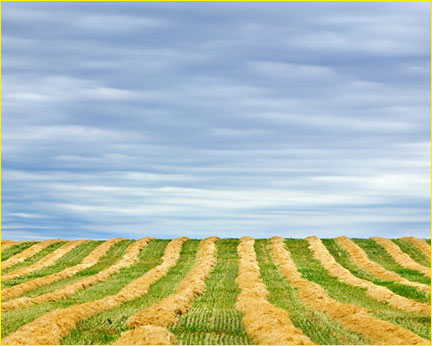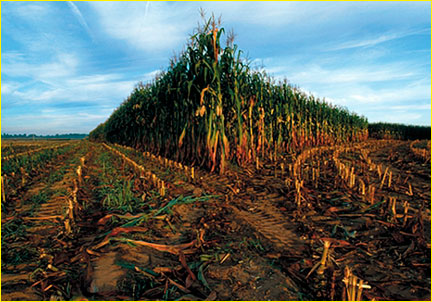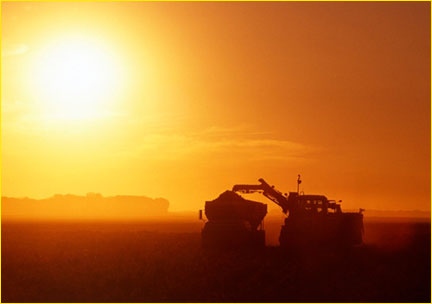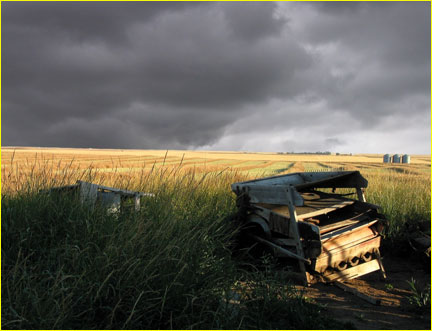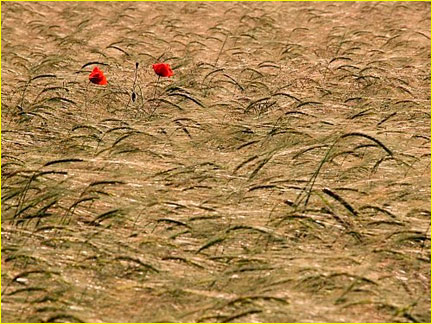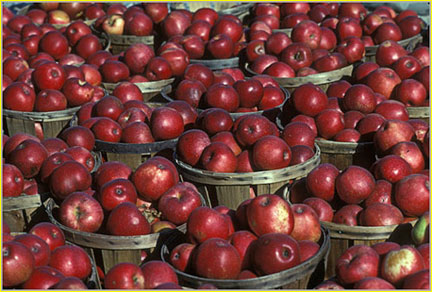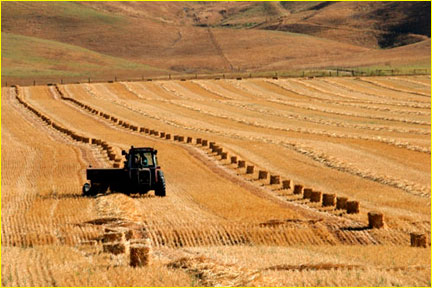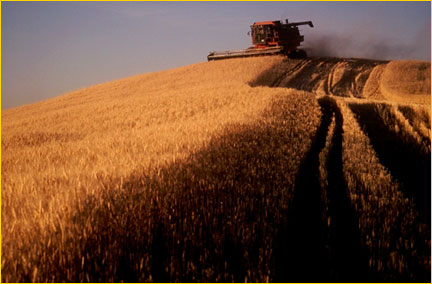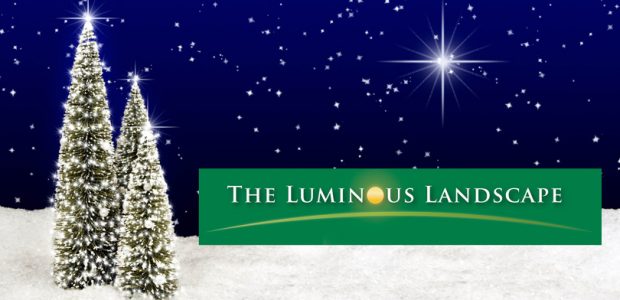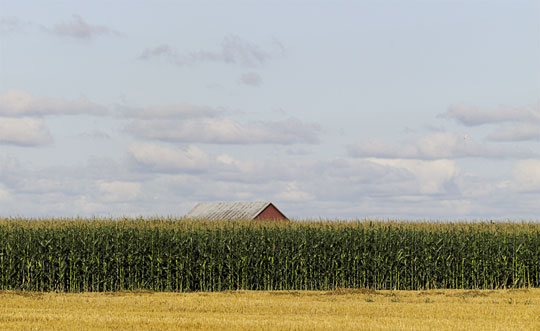
Corn Field — Ontario — August, 2003
By: Michael Reichmann
Contax 645 with Kodak DCS Pro Back
with 210mm f/4 Sonnar @ ISO 100
Competition #1 — September, 2003
This competition has as its theme —Harvest .The photograph above is illustrative of what I have in mind, but should by no means be taken as templates for whatyouproduce.
I will publish selected submission as they come in. Each competition lasts approximately a month, though depending on my travel schedule and workload any one competition may be cut short or extended.
Please note that not all submission will be published and critiqued. Only those which I feel are of particular interest (goodorbad) will be put online. Also, I can not enter into private correspondence about your submission. Rules for submission may be found at the bottom of this page.
Readers are welcome to add their comments about submissions on theDiscussion Forum.
This Competition is Now Closed
A new competition with a new theme will be announced shortly.
The winner is Collin Orthner, whose entry is seen immediately below.
While there were many strong submissions Collin’s best summarizes
the light, the activity and the beauty of the harvest.
Collin Orthner — Red Deer, Alberta, Canada
This image was made handheld in a moving combine through a fisheye lens.
My exposure was one second long.
Of course there was someone else driving!
Pentax LX, 16mm f2.8, Fujichrome Velvia.The curved horizon is of course the give-away that this is a fish-eye shot, but that quickly become secondary to the glorious light and feeling of motion. I almost feel like I’m sitting on the combine. Collins photograph shows that experimentation can be the key to first class images. Well seen and executed.
Kenneth Waller — Novi, Michigan
Pentax MZ-S, Pentax 300mm f4.5 FA lens, Bogen 3221 tripod & Mini gear head, Velvia @ 50.
Location – Palouse region of Washington StateThese fields have something of the feeling of crashing waves. I especially like the black V in the lower left. It gives the eye a starting point that leads into the frame. The long lens compression works perfectly — not too much, but enough to render the graphic nature of the furrows.
Jason Kasumovic — Edmonton, Alberta
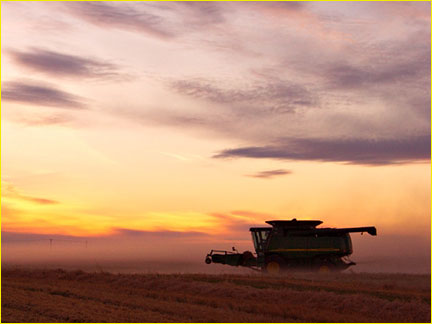
Shot at sunset just north of Edmonton, Alberta. The ‘mist’ is actually a combination of dust thrust up by the combine
and fog that resulted due to a very quick drop in temperature. Camera: Canon G2
Mid-day under a blue sky this would be a boring photograph. But the light and sky come together with a well composed subject to create a very strong image that’s hard not to like. I wouldn’t change a thing.
Eric Fredine — Edmonton, Alberta, Canada
I thought the combination of the horizontal clouds with the vertical rows
might make for a nice graphical image so I stopped to photograph it.
Captured with a Canon 1Ds, 70-200 @ 200.
Eric thought right! Sometimes its simplicity that creates the strongest images. Here we have colour contrasts as well as texture contrasts. The clouds create horizontal streaks while the hay rows and furrows lead the up upwards. It’s almost disconcerting how the bump up against each other. A very strong photograph.
Jim Newton — Cape Elizabeth, Me
Canon V1 with 24mm T/S
Kodak E100VSI feel like I’m looking at some sort of alien city, rather than a mundane scene of harvested and waiting corn rows. The image’s strength comes from the low angle and extended depth of field and is topped off with delicious warm light. Very nicely handled on both a technical and esthetic level.
Kenneth W Renton — Halifax, Nova Scotia
The image was taken last weekend on a visit to Ross farm which is a historic farm maintained by the Nova Scotia Tourism Board.
It was taken on a Canon S230 which I carry on my belt. I spotted this lone strand of grain while photographing the entire harvest laid out to dry.
I had spent the day using medium format black and white but having the tiny digital camera on my belt
often pays off. The image was sharpened and “tweeked” slightly with Photoshop.This simple yet charming photograph shows that great images can be created with almost any camera, and that all the fussing that is done about equipment shouldn’t be allowed to get in the way of getting out there and simply producing some good shots.
What "works" here is the contrast of shape, tonality and texture between the stalks and the one bent-over top.
Stan Wiebe — MacGregor, Manitoba
I am a farmer and an avid photo enthusiast so I am priveleged to many harvest scenes.
This one in particular is the harvesting of potatoes done at sunset. It was taken in my pre-digital days with a Nikon F4 on slide film.
I did not record any of the details of the shot as I was actually very busy harvesting.This photograph strongly evokes the feeling of "harvest". I can almost feel the heat and dust, and the smell of an early morning in the fields. The story has been told simply and directly. Very well seen and executed.
Jason Anderson — Calgary, Alberta
Picture taken, early evening, Saturday, August 30th,
30 kilometres east of High River, Alberta.
Camera: Canon G2A very evocative image. The threatening sky in the background contrasts well with the bright field and then unexpectedly the abandoned farm equipment rather than being dark and somber is illuminated by a shaft of light, while the grasses help frame it. But, the titled horizon line let’s the photograph down.
Lois Wakeman — Devon, UK
Nikon Coolpix 5700, ISO 100, f8, 1/000th sec, 71.4 mm (280mm equivalent)Taken in Uplyme, south west UK, just before cutting time, this shows a small patch of ground missed
by the herbicide sprayer earlier in the year. Some poppies and blackgrass are taking their chance in the sun,
having waited many years as dormant seeds, amidst a vast sea of barley.
I chose a narrow angle and limited DOF to emphasise both the focal point and
the vastness of the field, and liked the contrast between the wild, bright upstarts, and the monotonous monoculture.
Elegant in its simplicity, this photograph appeals because of the textures and colour contrasts. It doesn’t rise higher because the foreground grasses are out of focus, and in a subject with such intricate textures it’s disconcerting to have a foreground that’s soft. The human eye is much more forgiving of out of focus backgrounds, but when the foreground goes it’s rare that we can visually accommodate it.
Ian Laker — Littlebourne, Canterbury, Kent, England

Mamiya RZ67, 55mm Sekor lens, Lee 0.6 grey grad, Manfrotto tripod, Fuji Velvia.
I drive to work past this field everyday and observe the passing seasons and their effect on the landscape.
The play of light on this rolling valley at both the beginning and end of the day is what inspired me
to return one evening on a sunday last month. That and the round hay bales that I also find most attractive
and photogenic for reasons I can’t quite figure out. I also like the geometry of the stubble.
This scene encapsulates for me the charm of the Kent countryside among which I have lived my whole life.Ian’s photograph is captivating from the moment you first see it. There is a depth and dimensionality that draws the eye into the scene and the mind into the place and time. There are two different flows; the light flows from dark to light — right to left, while the rows of stubble lead the eye almost straight into the frame. A very successfully image.
Alan Rew — Didcot, Oxfordshire, UK
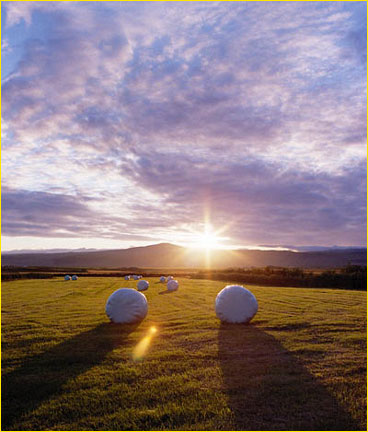
Olympus OM20 SLR, 28mm lens, Fujicolor Superia 200 film, Nikon LS40 film scanner, cropped and adjusted in Photoshop (mainly Curves).
Taken at sunset near Selfoss, Iceland, on my first holiday there in 1998. This was a lucky grab-shot,
as two minutes later the sun had set behind the mountains and the next morning the hay bales were taken away.
Sometimes the camera is an invisible presence. Sometimes it makes itself known. In this instances I am aware of both the camera and the photographer. The camera reveals its presence though the flare spot, and the photographer is revealed by the very conscious positioning of shooting directly into the sun. Neither is bad, per-se, nor good, but without these conceits I don’t find the image all that compelling. Sky. Bales. Sun. Shadows. But nothing new is revealed, or shown in a way that hasn’t been seen many times before.
James P. Nelson — Coralville, Iowa
Camera Canon V1, Canon f2.8 24-70mm lens, Kodak E100VS film
Summer 2003, early evening.Each summer in Southeast Iowa the Amish farmers help each other to bundle the oat crop.
They work together during the harvest season, cutting and shocking the oats,
which are vitally needed to feed their horses during the upcoming fall and winter seasons.
They dry the oat shocks in the fields, producing works of art from their hard labor.Close, but no cigar. The light is wonderful and the subject is strong, but the composition fails to work. There’s simply too much uninteresting space in the lower left third of the frame. Also, the road sign partially obscures the buggy and the trees are "messy". The field with its intense colour and strong shadows has the strongest interest, and the horse drawn buggy is a close second, but they don’t come together into a cohesive whole.
Paul Thompson — London, UK
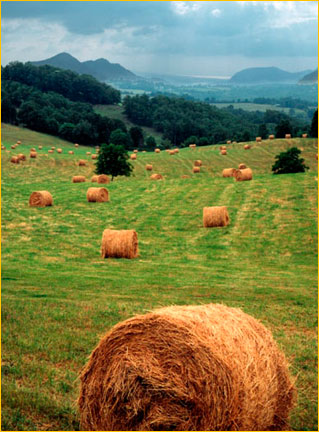
The photograph was taken on an Eos 5 with 28-105mm at 28mm.
Fuji provia film then scanned on an Artix scan 4000t and tweaked in photoshopGood photographs catch your eye immediately. No intellectualization is necessary, it just grabs you. This one does almost everything right. There’s strong foreground interest, an interesting mid-ground and a textured background,andthe sky is dark and dramatic. The colours are saturated (maybe a bit too much so) and I feel like I could step into the frame. Not great, butreallygood.
Adam Bulharowski — Tucson, Arizona
Nikkormat Ftn; Kodachrome K64Both the concept and execution are good. But, as the saying goes, "there’s always one bad apple". In this case the success of the photograph relies on symmetry and repletion, and symmetry is broken by the few apples that aren’t clean red in colour. These could easily be "fixed" in Photoshop. I would also crop the very top of the frame slightly to exclude anything except the baskets and apples.
Mike Malinowski — Livermore, CA
I used a 10D with a 70-200 (non-IS) early one morning when the hay was being transformed into bales.This is a case where the whole is less than the sum of the parts. Firstly, the area at the top of the frame is extraneous. By this I mean that it doesn’t add any information, or make an esthetic contribution to the image. The lines of bales lead the eye, but not to anything of interest, and because of the harsh light the tractor is close to being a black blob. Also, the bright out-of-focus foreground distracts.
Bill Stormont — Eugene, Oregon
Tech notes: Canon T90, FD24mm 2.8, Provia
Location: The Palouse area of eastern Washington stateWhen a combine enters a ripened wheat field for the first cut there is
an almost palpable sense of relief, of waiting finally over. The
farmer’s efforts, with Nature’s help, will now be found out. And yet
the following day, after the last bushels of grain are offloaded into a
waiting truck and the combine lumbers from the field to the next
section, the crunch of its huge tires across the wheat stubble is a
stark reminder that the cycle is complete, the season over, and there
is a faint hint of sadness that passes with the machine.This is a powerful image, well seen. The combine has an energy that can almost be felt. This is because of the smoke behind it, which invokes power as well as the wind, and also the slope to the left of frame which lends a tension-creating off-kilter feeling. The black lines of the already mowed path lead the eye upward, and contrasts nicely with the warm tones at left of frame. This is a first-rate image that any magazine editor looking to illustrate a "harvest" story would be pleased to publish.
The Rules
The rules are simple. But, if they are not adhered to your submission will not be considered.
1: All photographs must be original works created by the submitter.
2: Any type of photographic image produced with any equipment or technique is eligible.
3: You authorizeMichael ReichmannandThe Luminous Landscape Inc., one time rights to publish the photograph on this web site and to provide an online critique of the image.
4: Onlyoneimage may be submitted by the same individual for each competition.
5: Image submitted must be in JPG format at 72 PPI. The maximum dimension must be no greater than 500 pixels.
This is important.If you don’t comply your submission will be discarded!6: Images submitted must adhere to the following…
— have the wordsCritique Competitionin the title
— contain the sender’s name, country, state or province, city or town, and email address
— any brief technical details that you wish to share
7: Regrettably, I will not be able to enter into any correspondence regarding either accepted or declined images, other than what appears on this page.
The Prize
The prize for each competition’s winner will be a copy of the current issue ofThe Video Journal.
You May Also Enjoy...
Happy Holidays From Luminous-Landscape
FacebookTweet Merry Christmas and Happy Holidays From The Luminous-Landscape Team It’s been a busy and fun year at Luminous-Landscape. As we approach the end
